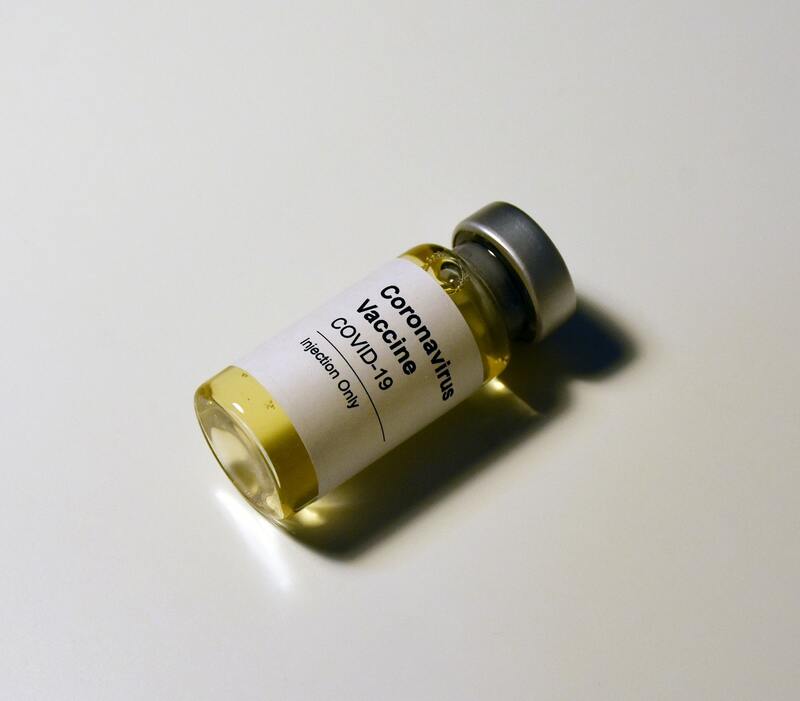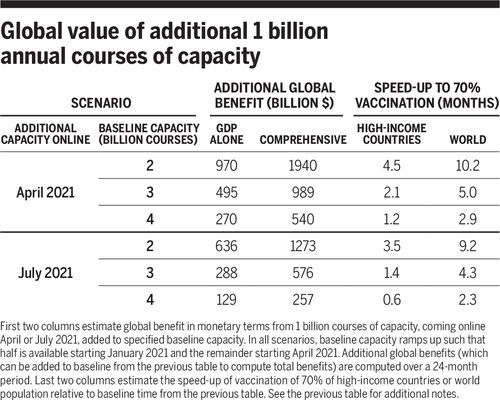Market design to accelerate COVID-19 vaccine supply

In contrast to my previous reviews, its time to jump straight into practice: how can economic market design be used in government decision making to alleviate the impacts from COVID-19?
In various countries, the share of people who received their first vaccine is already approaching or surpassing 50% at the time of writing. As a result, I find myself prone to think that in some ways, the fight is almost over. Government contracts have been negotiated, production capacity has been established, and regulators are not coming with new original proposals with regards to masks. Yes, we should stay vigilant, of course! But is this still a neglected area where strategic thinking can be of help?
Some would say yes:
Of the many mistakes that governments made in the last year I think the biggest one was to not not spend more money on the production of vaccines.
— Max Roser (@MaxCRoser) May 6, 2021
It cost thousands of lives, trillions of dollars, and many months of restrictions.
I think we are still making that same mistake.
The problem is, COVID is going to be around for a while. Although current vaccines all seem to offer protection from the current variants on the virus market, unless we vaccinate all people, dogs, cats, hamsters, ferrets and rabbits, there is a chance that COVID will linger around in the world. Moreover, vaccines don't offer protection forever. As a result, at this point many people believe that vaccinations for COVID may become as common as for the flu.
There is one more reason why investing more in capacity to prevent the spread of COVID is of use for the world: there may be spillover effects which enhance our protection from other viruses! Experts have warned about pandemics for years, and even though society may not have the bandwidth to accurately filter through all scientists claims, I'll take the assumption going forward that we've still been investing too little in vaccine capacity.
COVID could've been 10 times as deadly. We've been lucky. But fear not, because there is still room to socially engineer ourselves forward!
The tools in our toolkit
There are a number of tools which governments can use in order to speed up the deployment of vaccines:
(1) Contract on capacity versus output
What this means is that governments should reward producers not based on the number of vaccines produced, but on increasing the amount of vaccines that they can produce. This highlights the long-term importance which COVID vaccines will play in our lives. Although in simplified economic models you could try to design tight contracts on capacity, real-world human behaviour makes this hard to achieve:
"An advance contract for the delivery of a set number of courses for a set price may provide too little incentive for speed if not structured thoughtfully (6). Unless bound by an explicit capacity commitment or delivery date, the firm's commercial incentives are to save costs by investing in smaller capacity, fulfilling the order over a longer period but generating the same revenue from the contract. Although buyers could try to eliminate delays by specifying deadlines for delivery, these may slip (as many existing contracts have) unless backed by late penalties. However, firms are unlikely to accept contracts with substantial penalties that reflect the full social cost of delay."
(2) Relax supply-chain constraints
What about the suppliers of the vaccine producers? Can we be sure that the producers of vials, fridges and lab coats are up for challenge? In theory the pricing mechanism of the market should take care of activating them. However, in order for markets to work optimally, profit-maximizing entities should be free to make the kind of contracts they want without transaction costs or time. And in the real-world, that's not always possible. Time puts a really big constraint on people! Moreover, this beautiful academically titled paper brings forward another issue: Repugnance as a Constraint on Markets. There are many instances where a price surge of certain goods is deemed immoral, for example because it may cause the poorest to lose access to the goods. As noted in a previous essay: there is again a trade-off between economic efficiency and equality.
You may remember a famous case of Martin Skhreli who increased the price of a drug by 5600%. Whatever the background story and regardless of whether poor people get the drug for free, seeing such an increase in price shocks people. So instead of waiting for a price increase to signal to suppliers that they should flock into the market, government contracts can act as a substitute:
"To justify an expansion of input capacity commercially, a short-term price surge may be needed. Social constraints on pricing during a pandemic may preclude surges (9), however, resulting in shortages of intermediate goods. Public agencies may need to intervene in the input market, building input stockpiles in anticipation of manufacturing scale-up or signing contracts for the installation of new input capacity."
(3) Solicit bids
Taking the above point even more serious: besides not trusting market players to make "optimal" decisions when interacting, we may not even be able to trust market players to make "optimal" decisions for themselves. Excuse the use of scare quotes; I mean optimal only from an idealistic government perspective here!
So when would the government be a better decision maker than companies? The classic economic paper The Use of Knowledge in Society makes the case that it is all about who has what information available, and who is able to capitalize on them. Something that I have felt personally: there are always more opportunities available in life than you have time to manage. And when governments know there is a single clear target to pursue, such as killing a mutating virus, they may well be able to make some good decisions towards that target:
"By soliciting bids from firms for capacity expansion (whether by installing new factories, repurposing existing ones, or finding ways to increase yield), governments could discover potential opportunities and their costs, allowing them to make informed investment decisions. Our analysis suggests that governments should aim to install substantial capacity even if they must pay a higher price for marginal units of capacity than in deals to date."
(4) Decrease vaccine hesitancy
This is not from today's paper but after seeing a recent New York Times article I thought it was too relevant to ignore! In order to decrease vaccine hesitancy of the public, governments employ many different schemes: from advertisements, to weed, to public endorsements. A very direct alternative approach would be to offer direct cash rewards to people. Your mileage may vary depending on the culture:
"A cash reward works best with Democrats, and relaxing safety guidelines seems to motivate Republicans, a survey study shows."
Recommendations outside of market-design
Furthermore, there are more non-economic recommendations which the authors of today's paper make, which may seem counter to conventional wisdom but become useful in an environment where an exponentially growing virus is so widespread:
- Dosing regimens: prioritize giving smaller and first doses as opposed to bigger and second doses.
- Vaccine trials: increasing the scope of vaccine trials can provide valuable data on optimal vaccines and dosing regimes.
- Utilizing lower-efficacy vaccines: similar to prioritizing small first doses, even non-effective vaccines may be a lot more useful than having to wait for a vaccine.
- Cross-country vaccine exchange:
"As more vaccines are approved, given the scramble to secure bilateral deals, the nature of the fair allocation protocol adopted by COVAX (a global initiative to promote access to COVID-19 vaccines), and rapidly changing circumstances, some countries may end up with vaccine allocations that are not optimally matched to their needs. For example, some countries may have difficulty handling vaccines requiring ultracold storage or may be willing to trade off a small reduction in efficacy for a large increase in quantity. Countries allocated several vaccines may prefer to simplify logistics by consolidating on one or two.
To facilitate efficient allocation across countries, a vaccine exchange mechanism is under consideration by COVAX. The mechanism would enable countries to engage in mutually beneficial trades of vaccine courses. Centralized market clearing will help aggregate the willingness of all countries to trade, thus maximizing gains from trade and minimizing waste of scarce vaccine courses."
Estimating how much to use the tools
After having summed up so many policies and ideas, the question remains how much they should be used. There is one formula which economist Alex Tabarrok has mentioned repeatedly, showing government costs on the left, and societal benefits on the right:
Billions < Trillions
According to a variety of sources, monthly global GDP loss may amount to 500-3500 billion USD. The former estimation looks just at short-term GDP impacts, while the latter aims to take into account more factors like loss of education and harm to human capital. Mind you that governments have been spending 1.5 trillion USD per month on fiscal support to companies and citizens, which would no longer be needed if enough people were vaccinated.
More subjective factors can be taken into account which may increase of decrease the estimates losses: income inequality seems to have increased, nature has restored, and humanity was able to enjoy another nature movie narrated by David Attenbrough about how much nature has restored. A full account of all externalities is out of scope for this blog post and the authors of today's paper are content with using an annual loss of 500-1000 billion USD.
With that in mind, governments should aim to collectively spend hundreds of billions to hasten to reduction of COVID. Unfortunately I couldn't find data on total existing government spending on vaccines, but the author's of today's paper make recommendations by looking at the fact that 3 billion courses of annual capacity seem to be currently in place.

In conclusion
There are a variety of methods which governments all over the world can execute to increase the world's resilience against the current pandemic, but also against future pandemics. Pandemics are one of the biggest threats to society, and COVID has given us a slight taste of how bad things can get.
By taking an active role in contracting with vaccine producers ánd their suppliers, vaccine production can be scaled up. This will cost a lot of money, but it is worth it, because billions < trillions.
Today's paper dealt with quite a heavy topic: preventing worldwide collapse with economic mechanism design. Therefore, thank you very much for reading, let me know what you think of the mechanisms, and make sure to enjoy a good David Attenborough documentary to relax. Let's hope its the last pandemic-related one.
